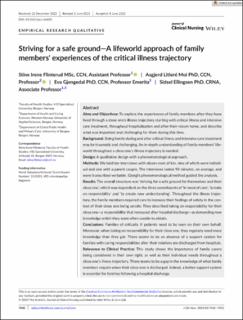| dc.contributor.author | Flinterud, Stine Irene | |
| dc.contributor.author | Moi, Asgjerd Litleré | |
| dc.contributor.author | Gjengedal, Eva | |
| dc.contributor.author | Ellingsen, Sidsel | |
| dc.date.accessioned | 2024-01-16T08:41:25Z | |
| dc.date.available | 2024-01-16T08:41:25Z | |
| dc.date.created | 2023-06-26T10:08:42Z | |
| dc.date.issued | 2023 | |
| dc.identifier.citation | Journal of Clinical Nursing (JCN).2023, 32 (19-20), 7442 - 7453 | en_US |
| dc.identifier.issn | 0962-1067 | |
| dc.identifier.uri | https://hdl.handle.net/11250/3111657 | |
| dc.description | This is an open access article under the terms of the Creative Commons Attribution-NonCommercial-NoDerivs License, which permits use and distribution in any medium, provided the original work is properly cited, the use is non-commercial and no modifications or adaptations are made. | en_US |
| dc.description.abstract | Aims and Objectives: To explore the experiences of family members after they have lived through a close one's illness trajectory starting with critical illness and intensive care treatment, throughout hospitalisation and after their return home, and describe what was important and challenging for them during this time.
Background: Being family during and after critical illness and intensive care treatment may be traumatic and challenging. An in-depth understanding of family members’ lifeworld throughout a close one's illness trajectory is needed.
Design: A qualitative design with a phenomenological approach.
Methods: We held ten interviews with eleven next of kin, nine of which were individual and one with a parent couple. The interviews lasted 90 minutes, on average, and were transcribed verbatim. Giorgi's phenomenological method guided the analysis.
Results: The overall structure was ‘striving for a safe ground for themselves and their close one’, which was dependent on the three constituents of ‘in need of care’, ‘to take on responsibility’ and ‘to create new understanding’. Throughout the illness trajectory, the family members required care to increase their feelings of safety in the context of their close one being unsafe. They described taking on responsibility for their close one—a responsibility that increased after hospital discharge—as demanding new knowledge which they were often unable to obtain.
Conclusions: Families of critically ill patients need to be seen on their own behalf. Moreover, when taking on responsibility for their close one, they regularly need more knowledge than they get. There seems to be an absence of a support system for families with caring responsibilities after their relatives are discharged from hospitals.
Relevance to Clinical Practice: This study shows the importance of family carers being considered in their own right, as well as their individual needs throughout a close one's illness trajectory. There seems to be a gap in the knowledge of what family members require when their close one is discharged. Indeed, a better support system is essential for families following a hospital discharge. | en_US |
| dc.language.iso | eng | en_US |
| dc.publisher | John Wiley & Sons | en_US |
| dc.rights | Attribution-NonCommercial-NoDerivatives 4.0 Internasjonal | * |
| dc.rights.uri | http://creativecommons.org/licenses/by-nc-nd/4.0/deed.no | * |
| dc.subject | qualitative methods | en_US |
| dc.subject | phenomenology | en_US |
| dc.subject | next of kin | en_US |
| dc.subject | intensive care | en_US |
| dc.subject | family support | en_US |
| dc.subject | family | en_US |
| dc.subject | critical care | en_US |
| dc.title | Striving for a safe ground—A lifeworld approach of family members' experiences of the critical illness trajectory | en_US |
| dc.type | Peer reviewed | en_US |
| dc.type | Journal article | en_US |
| dc.description.version | publishedVersion | en_US |
| dc.rights.holder | © 2023 The Authors. Journal of Clinical Nursing published by John Wiley & Sons Ltd. | en_US |
| dc.source.pagenumber | 7442 - 7453 | en_US |
| dc.source.volume | 32 | en_US |
| dc.source.journal | Journal of Clinical Nursing (JCN) | en_US |
| dc.source.issue | 19-20 | en_US |
| dc.identifier.doi | 10.1111/jocn.16803 | |
| dc.identifier.cristin | 2157827 | |
| cristin.ispublished | true | |
| cristin.fulltext | original | |
| cristin.qualitycode | 2 | |

